#iron age england
Text
"Dr Sarah Stark, a human skeletal biologist at Historic England, said the findings provided “evidence of a leading role for a woman in warfare on iron age Scilly.”
“Although we can never know completely about the symbolism of objects found in graves, the combination of a sword and a mirror suggests this woman had high status within her community and may have played a commanding role in local warfare, organising or leading raids on rival groups.”
Stark added: “This could suggest that female involvement in raiding and other types of violence was more common in iron age society than we’ve previously thought, and it could have laid the foundations from which leaders like Boudicca would later emerge.”"
#warriors#history#women in history#warrior women#women warriors#women's history#iron age#archeology#england#english history
424 notes
·
View notes
Text
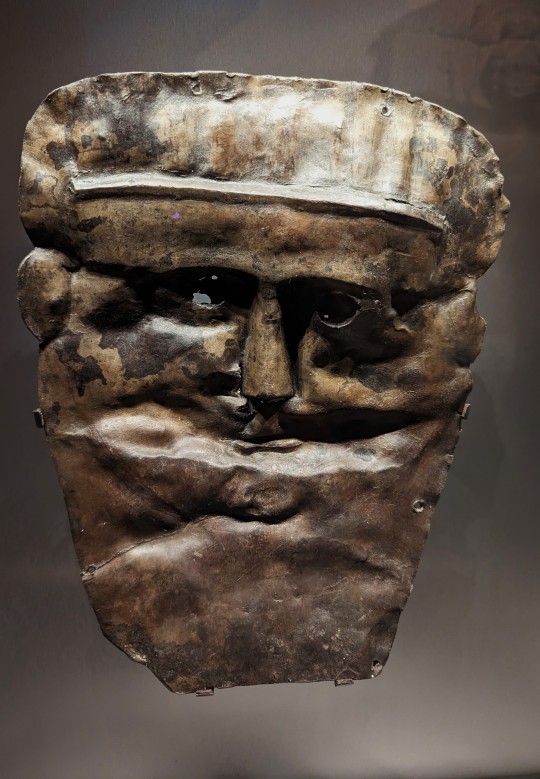
Religious Mask from Bath, England dated between the 1st and 4th Centuries on display at the Roman Baths Museum in Bath, England
Photographs taken by myself 2023
#art#archaeology#history#fashion#roman empire#england#english#ancient#iron age#roman baths museum#bath#barbucomedie
114 notes
·
View notes
Text

Remnants of a ringed iron age hill fort built at Old Sarum, dated to 400 B.C., plus later structural remnants, in Salisbury, England.
931 notes
·
View notes
Text



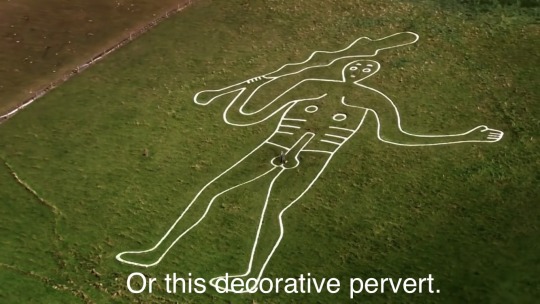


To make sure they stabbed the right people, ancient Britons formed primitive gangs, called tribes, and like many gangs they got into graffiti - vandalizing the countryside with gigantic doodles. Like this badly drawn horse. Or this decorative pervert.
Before Snapchat, hills were the most efficient way to distribute dick pics to a wide audience. As a result, Cerne Abbas became the second rudest hill in British history - after Benny.”
#cunk on britain#philomena cunk#diane morgan#british history#uffington white horse#Cerne abbas giant#prehistory#Iron Age#bronze age#Britain#England
273 notes
·
View notes
Text
Archaeologists from DigVentures have made an extraordinary find in the English countryside: an Iron Age blacksmith workshop dating back to 770-515 BC, nestled in the heart of Oxfordshire. This rare discovery reveals the advanced craftsmanship of one of Britain's earliest master blacksmiths, complete with bellow protectors and tiny metal fragments - remnants of a bygone era where red-hot iron was skillfully transformed.
25 notes
·
View notes
Text
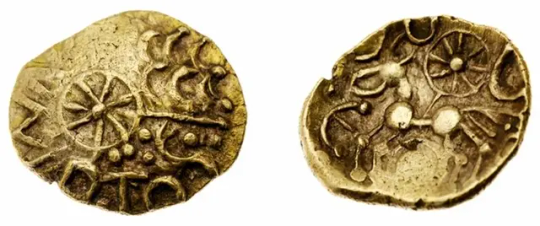
Gold Coin Reveals Unknown British King
New light has been shed on a little-known part of British history thanks to the extraordinary discovery of a coin bearing the name of a forgotten Iron Age ruler in Hampshire, south-east England.
The coin, which has the inscription “Esunertos,” was discovered by a metal detectorist in a field in Hampshire. Esunertos may have ruled as a king from the powerful Danebury Fort, according to experts’ speculation, and this find has been hailed as “one of the outstanding discoveries of recent decades.”
Leading Iron Age experts have studied the coin and deduced it to be struck by a pre-eminent male figure dubbed ‘IISVNIRTOS’ whose name translates as ‘Mighty as the God Esos’.
The coin was struck sometime between 50 and 30 BC, shortly after Julius Caesar’s first Roman raid of Britain in 55 BC.
The coin, which is thought to have been produced between 50 and 30 BC, was struck in conjunction with Julius Caesar’s first Roman raid on Britain in 55 BC when the Roman general and his 20,000 soldiers landed on the Kent coast. Despite a confrontation with Celtic warriors on the beach, the Romans encountered difficulties landing due to rough seas and eventually had to return home.
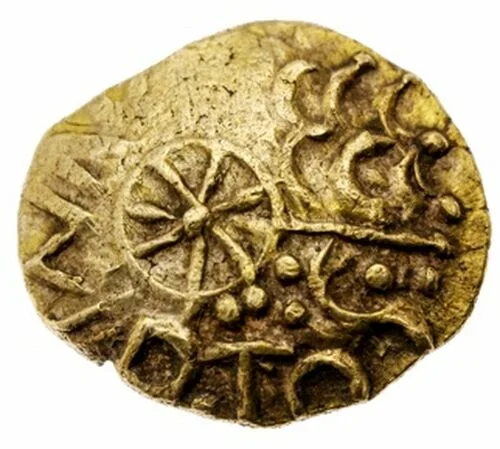
Gregory Edmund, Iron Age Coin Specialist at Spink Auctioneers said: “This fabulous piece of prehistoric artwork completes the mental image we have when we think of Iron Age Britain – the war horse and chariot.
“But it also surprises us with the appearance of classical languages like Latin.
Dr John Sills of the Celtic Coin Index at the Ashmolean Museum said: ‘It is one of the outstanding discoveries of recent decades in Celtic numismatics.’
Initially, it was anticipated that the gold coin would sell for around £4,000 ($5000) at auction. But contrary to all expectations, it broke a record at Spinks Auction by selling for an astounding £20,400 ($25,500).
The coin was found by Lewis Fudge, a metal detectorist who received permission to search a farmer’s field in March this year. Lewis Fudge expressed his elation, stating:
“I am over the moon. If it were not for people in the auction room, I would have jumped around. The collectors I spoke to are gobsmacked. I’m so glad I did not take them up on their private offers before the auction. To think my find has generated its own Wikipedia page is incredible.”
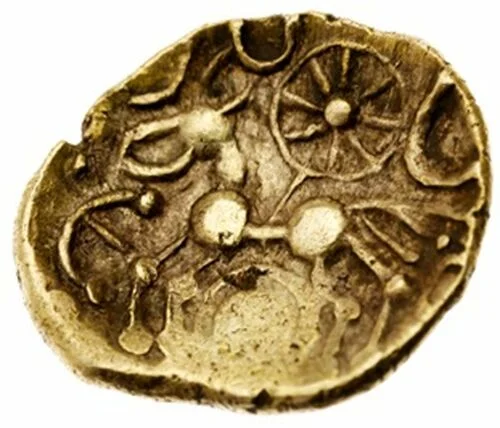
Spink Auctions describe the coin as a quarter slater with the obverse side of the coin bearing the name Esunertos in Latin, and with the worn head of Apollo formed of three interlocking rows of outward facing crescents, a seven-spoked wheel at center in lieu of the ear, and an eye of visage with radiating spike towards the neckline.
The reverse of the coin has a tripled-tailed horse, with a pincer-like mandible for face and linear ear, with pelleted mane, yoke or bucranium above the head, an 8-spoked wheel above spearing into the horse’s back, and double or triple ringed annulet below.
By Leman Altuntaş.

#Gold Coin Reveals Unknown British King#Hampshire England#Danebury Fort#Esunertos#gold#gold coin#ancient gold coin#ancient artifacts#archeology#archeolgst#metal detecting#history#history news#ancient history#ancient culture#ancient civilizations#iron age#celtic history
41 notes
·
View notes
Text
writing a scene that takes place in Late Antiquity of Arthur and Morgan burying their mother, and it's supposed to somber, right? it's a funeral scene. they just lost their mom, who before then had come back from death countless times. it's supposed to be sad and uncertain and unnerving.
however. it is somewhat difficult to achieve this tone when the funeral involves them casually dismembering the body so they can make combs and flutes from the skeleton. Arthur insists on having a tibia. they argue over who gets the skull. it's not supposed to be humorous but I have no idea how to make this serious.
I just wanted the scene to be historically and culturally accurate so this is my punishment ig.
#hws england#hws wales#hws britannia#ftr bronze and iron age funerary practices in britain varied considerably and were generally pretty individualistic#but a common theme was that most of the remains were in pieces after being exhumed once or even multiple times#meaning they dug up their relatives and made keepsakes from their remains and idk how to handle that#anyway Arthur makes a comb from his mother's corpse and may even still have it in the modern day
20 notes
·
View notes
Text
It is difficult to answer the question ‘what happened to the Celts?’ because they never really went anywhere. The people – and their art, culture and DNA – were absorbed into other empires, kingdoms and societies. Some areas of Britain, such as what is now Wales, Scotland and Cornwall, remained largely free of Roman influence, while Ireland was never part of the Roman empire. All later helped to reintroduce Celtic art and tradition back into what was once the province of Britannia. Elsewhere, Celtic culture fused with English, Danish and Norman influences to create a distinctive style all of its own.
It is only really within the last few centuries that the term ‘Celtic’ has taken on a more political dimension, being linked with concepts of Welsh, Scottish, Irish, Cornish, Gallician or Breton independence in the face of perceived English, Spanish or French political domination.
Throughout the 19th and 20th centuries, Celtic art, culture, language and tradition have been resuscitated and used, not only as symbols of resistance, but also of identity and common ancestry, especially among those descended from emigrant groups in the USA, Canada, South America and Australia.
Although this new form of Celtic identity is far removed from its prehistoric origins, it is surely testament to the powerful nature of this most distinctive and magnificent of ancient civilisations.
— The Celts: Who Were They, Where Did They Live, & What Happened After The Romans Left Britain?
#miles russell#the celts: who were they where did they live & what happened after the romans left britain?#history#ethnicity#politics#identity#art#art history#iron age#celts#celtic britons#britain#wales#scotland#england#cornwall#ireland#northern ireland#spain#portugal#france#galicia#bretagne
19 notes
·
View notes
Text
learning about the history of wood cover in great britain. i am blaming the romans for a considerable part of this.
#there seemed to have been fairly okay ? management of the woods by the bronze and iron age brits but that did mean lots of heathland#for grazing. bc wood cover went down to about 50% of england in the iron age with lots of heath moor and fenland#but the domesday book only reports 15% cover in 1086 and 10% by 1350#and its 8.4% now so actually there was really not much cut down for the industrial revolution
3 notes
·
View notes
Text


Infinite Dreams - Iron Maiden Maiden England '88
#iron maiden#iron maiden photoset#iron maiden infinite dreams#mine#iron maiden gif#iron maiden gifs#maiden england#maiden england 88#iron maiden live#iron maiden live maiden england#bruce dickinson was MY AGE HERE#OMG#i am just a fucking loser making gifs
3 notes
·
View notes
Text
me on my way to watch England v Ireland at the pub today knowing full well I’m abt to hear rowdy men call George ford homophobic slurs

#he’s an honorary member of the community TO ME#you would think it would be ironic for him to be called slurs by Ireland fans given his most prolific allegations are eith the Ireland#coach’s son… alas#I am kidding it’s mostly England fans who jeer at him 😭#call him an old age pensioner and a f slur like wow look at this champion of diversity in sport#tbf it’s mostly not slurs. mostly just ‘he’s sucking off thr ref’ vibes#he’s my favourite little guy he’s compelling to me
1 note
·
View note
Video
youtube
Maiden Castle, Dorset. #castle #dorset #dorchester #ironage #hillfort #m...
#youtube#castle#iron age#hill fort#history#historic england#dorset#dorchester#maiden#maiden castle#travel#places to visit#places to go#mound#hill
0 notes
Text

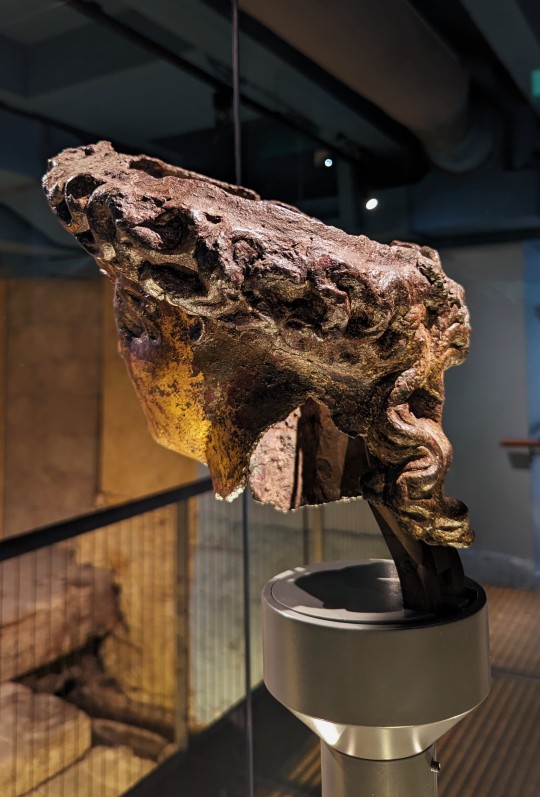
Bronze Head of Sulis Minerva from the Bath, England dated to the Late 1st Century on display at the Roman Baths Museum in Bath, England
This bronze head was discovered in 1727 and was an early indication that the Roman site at Bath was not a typical settlement. Gilt bronze sculptures are rare finds from Roman Britain as only two other fragments are known.
The head is probably from the cult statue of the goddess which would have stood within her Temple beside the Sacred Spring. From there she may have looked out across the Temple courtyard to the site of the great altar, the site of sacrifice, which stood at the heart of that sacred space. The statue may well be an original object from the foundation of the site in the later first century CE, which means that it was probably well over 300 years old when it met its demise.
The head is slightly larger than life size, suggesting that the original statue was an imposing sight. Hidden in the hair line are several small holes which once held rivets that fixed her tall Corinthian helmet to her head.
Examination of the head has revealed that it has six layers of gilding. The first two use a technique known as fire gilding whilst the four later layers are applied as gold leaf. The head has a number of imperfections. There is corrosion which has affected it in parts where it lay in the ground for over a thousand years. There is also a strange rectangular cut beneath the chin. It is thought that this may result from a flaw in the original casting process in which a bubble on the surface may have been cut out and filled with an inserted plate. When gilded over it would not have been visible. This plate has subsequently fallen out as a result of corrosion whilst in the ground.
Photographs taken by myself 2023
#art#archaeology#history#roman empire#english#england#ancient#iron age#roman baths museum#bath#barbucomedie
103 notes
·
View notes
Note
obsessed with these green things called trees

#this novella wasnt what i expected it to be at all but i was fascinated the entire time#i dont think ive read anything like it before#spent the entire time getting sicker and sicker and learned sooo much abt iron age england it was so interesting#bogs also <3
0 notes
Text
In 1999, a farmer stumbled upon an Iron Age grave on Bryher, a small island southwest of England. Inside was a remarkably rich burial, complete with objects like a copper alloy brooch and spiral ring, according to the Art Newspaper’s Maev Kennedy.
Two of the items were especially intriguing: a sword and a mirror. During the period, swords were usually buried alongside men, while mirrors were buried alongside women. So who was the mysterious individual who was buried with both?
“That combination of the two is what threw everyone in archaeology when it was first discovered,” Sarah Stark, a human skeletal biologist at Historic England, tells the Washington Post’s Victoria Bisset.
Now, researchers say they have the answer to the mystery that stumped experts for more than 20 years: The grave belongs to a woman warrior who played a leading role in warfare, according to a study published yesterday in the Journal of Archaeological Science: Reports.
Scientists came to this conclusion by analyzing tooth enamel, which has proteins that vary based on sex. While previous attempts at DNA analysis failed due to the poor condition of the recovered remains—tiny pieces of bone and teeth weighing around 150 grams—enamel is one of the body’s most durable substances, allowing researchers to calculate with 96 percent probability that the warrior was a woman.
“Given the degraded state of the bones, it’s remarkable to get such a strong result. It makes you wonder what could be discovered by re-visiting other badly degraded burials,” says Glendon Parker, an environmental toxicologist at the University of California, Davis, and co-author of the study, in a statement from Historic England.
Enamel analysis has already helped scientists in similar cases, including the recent discovery that Spain’s so-called “Ivory Man” was actually a woman. Stark, who is also a co-author of the study, is interested in analyzing additional burials similar to the one on Bryher. “We might start to uncover more of these hidden female warriors,” she tells the Washington Post.
Discovering that the grave belonged to a woman offers new insights into life in Iron Age Britain. At the time, violence between communities was common. Even mirrors, used to signal or coordinate attacks, could be part of warfare, according to Historic England.They were also used for ritualistic purposes, such as communicating with the supernatural world to ensure victory in an upcoming battle.
“Although we can never know completely about the symbolism of objects found in graves, the combination of a sword and a mirror suggests this woman had high status within her community and may have played a commanding role in local warfare, organizing or leading raids on rival groups,” says Stark in Historic England’s statement. “This could suggest that female involvement in raiding and other types of violence was more common in Iron Age society than we’ve previously thought.”
Kate Hales, a curator at the Isles of Scilly Museum, where the mirror and sword are housed, says the new findings help tell a new story about the items.
“Visitors have been captivated by the mystery that surrounds them,” she tells BBC News’ Brodie Owen. “It’s fascinating to know they were buried with a young woman and we look forward to reinterpreting her story, wondering about the kind of life she led, thousands of years ago on our now tranquil islands.”
0 notes
Text
A new British King has been discovered through the name on an Iron Age coin recently found by a metal detectorist. Welcome King Esunertos into the history books!
43 notes
·
View notes